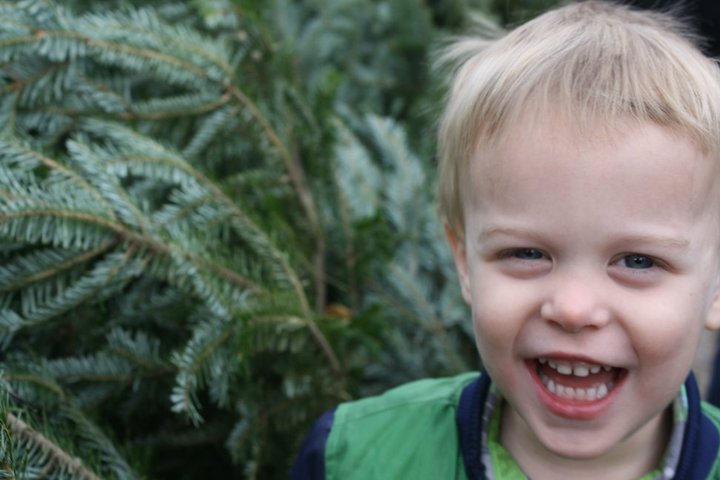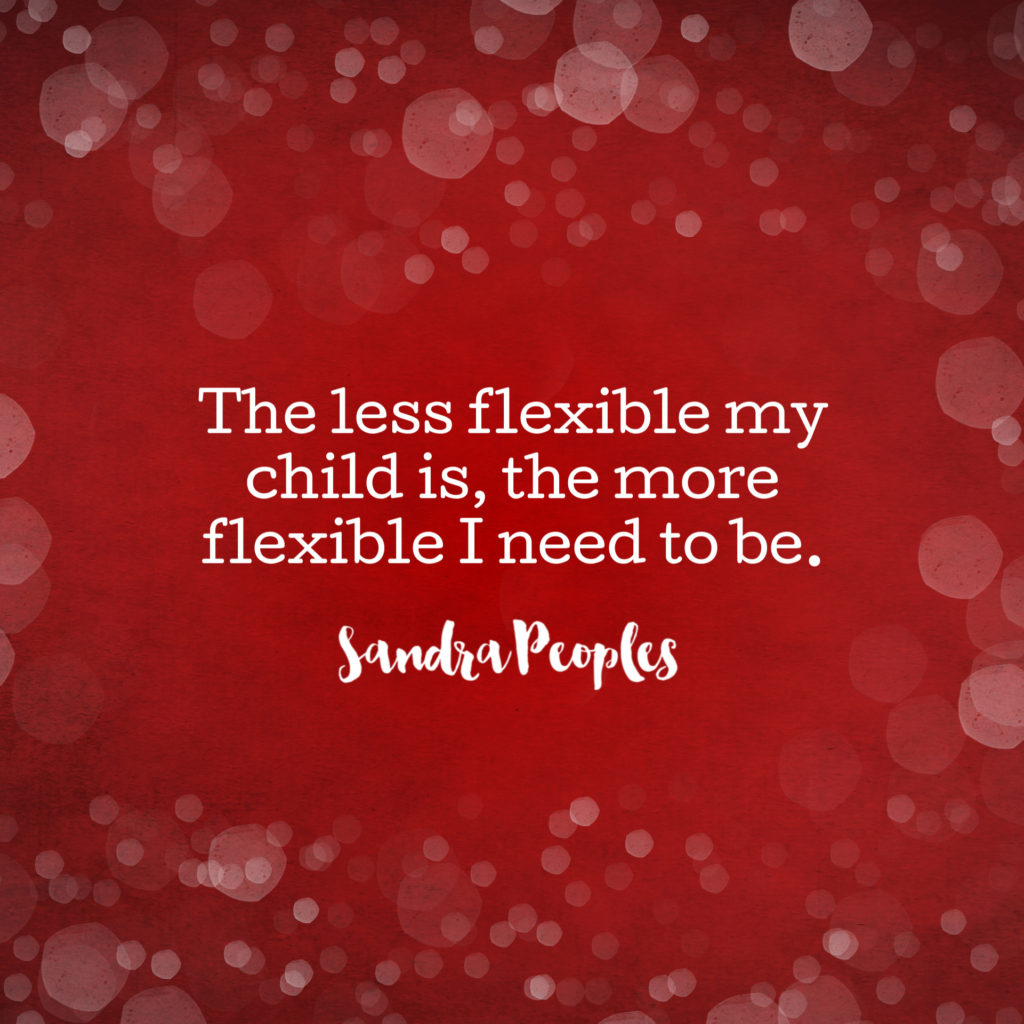One big challenge for special-needs families this time of year is how different it is from the rest of the year. Our kids are out of their regular routine and are bombarded with extra sensory input. In this episode, Sandra will give practical tips to help our kids regulate their sensory needs and remain calm when they are out of their regular routines. Remember this advice, “The less flexible my child is, the more flexible I need to be.”
Listen to Self Care and Soul Care for the Caregiver on iTunes or the link below.
Quick Links from the Episode:
- visual timer
- The Sweet Smell of Christmas book
- chew tubes
- indoor trampoline
- small ballpit
- swing
- noise reducing headphones
Other Posts You May Enjoy:
-
Keys To A Calm Christmas: Managing Our Emotions And Responses
-
Navigating Complicated Family Relationships With Diane Dokko Kim
- Supporting Grieving Families During the Holidays

Transcript:
This is self care and soul care for the care giver, and I’m your host—Sandra Peoples. To us, self care isn’t a luxury, it’s a necessity. We want to take better care of ourselves so we’re able to care for our loved ones who rely on us.
This is episode three, and we’re doing a series about the keys to a calm Christmas. In episode one we talked about responding to others’ expectations of our families. In episode 2 we focused on managing our own emotions and responses. Today is especially for those of us who have children with special needs. I’m going to share tips for helping them regulate their sensory needs and remain calm when they are out of their regular routines.
Christmas break can be especially tough on our kids, and therefore on the entire family, but I hope today’s episode helps! Be sure to listen all the way to the end to find out how to listen to a bonus episode.
Today we’re talking about one of the biggest challenges at our house—the lack of routine when we’re out for Christmas break. Even though it’s just two weeks, those two weeks are packed with extra church services and family activities. No day is exactly like the one before, and for our kids who thrive on routine, this can be really hard.
If you and I haven’t already connected through my website, books, or social media, let me tell you a little bit about my family. We live outside of Houston, TX where my husband is a pastor. We have two boys, David and James. James is 12 years old and has level 3 autism, along with what we call comorbid diagnoses like anxiety and OCD. He’s a sensory seeker who is on the move all day until he crashes at night (often not sleeping as long as we’d like!)
I have lots of practical ideas to share today, but I first want to share my go-to phrase for Christmas break:
The less flexible my child is, the more flexible I need to be.

I’m the adult and I have to act like it, even when I’m feeling stressed or embarrassed. That means I may have to bend some of my usual standards to keep the peace.
For example, I have a friend with three kids on the autism spectrum, and we talked about what was causing the most stress in her day. “When they don’t make their beds it sets me off in the mornings. I get angry, and they shut down. It can ruin the entire day.” Here’s my solution: don’t make them make their beds. If it’s that stressful, is a made bed really worth it? Doesn’t sound like it. Or, take steps to decrease the stress before or after they are supposed to make their beds. The night before you can go over the schedule for tomorrow morning: “After you get dressed and put your pajamas in the dirty clothes hamper, you make your bed.” On the way out the door if you notice it isn’t done, make another plan, “As soon as we get back, we’re going to make your bed together.”
We have to be flexible when we go out to eat, when we ride in the car for a long time, when our kids have to wear clothes they don’t like. Whatever situation is the most challenging in your day, find a way to be more flexible, to give in a little so the entire day doesn’t break apart.
A few years ago Hurricane Harvey hit our area. As I watched the newscasts, especially from the coast, I noticed the palm trees bending as the wind whipped by, gusting well over 100 miles per hour. They bent, but they didn’t break. Why? Because God created them to be flexible. I don’t want to break this Christmas season, so I will remember the palm tree and be flexible when it’s best for my family.
Here are other ways we’ve learned to help our kids when they are out of their routine:
- We use “first, then” throughout the day. “First we’ll eat breakfast, then you can get on your iPad,” or “First we’ll go to church, then we’ll go to Grandma’s house and open presents.” It helps James to know what’s coming next.
- Make a visual schedule. This was so helpful for us over summer break! I printed out pictures of him doing most of the activities we did in a week. Then I put them on a dry-erase board in order of our day. Even small things like “read books” and “rest time” were on the board. That way he knew what to expect for the entire day.
- Use a timer. For James we use a visual timer so he can see how much time is left until the next activity. For our older son David (who is typical, but also thrives on routine and doesn’t like being surprised), we can just give him a count down, “You have 10 more minutes on the X-box and then it’s time for lunch.”
Another cause of stress over the Christmas break is sensory issues.
One of my favorite Christmas books when I was growing up was The Sweet Smell of Christmas, a scented story book. You could scratch and sniff a pine tree, an orange, hot chocolate, and a candy cane.
But when I bought it for my own boys, they reacted to it differently than I did over thirty years ago. David wrinkled his nose, “Too smelly!” he said and didn’t want to open it again. James loved the smells, and carried it around, scratching the smelly spots in the book until there wasn’t anything left to smell.
When I observed my sensory avoider and my sensory seeker reading that book, it helped me realize all the sensory experiences Christmas brings. Think of the changes in temperature (especially if you live in a cold climate like we did when we lived in Pennsylvania), which also bring changes to the clothes your kids have to wear—shoes and sock or maybe itchy hats or scarves. And the lights you put on the tree and around the outside of the house that twinkle. And the extra noise of Christmas songs we love to play this time of year even if your home is normally quieter. And the smells of cookies baking or apple cider simmering. All these details are what makes Christmas feel like Christmas to most of us, but our kids can be overwhelmed by the changes.
When we’re out of school for breaks, we plan a “sensory diet” to make sure James is getting his sensory needs met. He’s mostly a sensory seeker, but he has some big avoidances as well. I hope these ideas help your family:
For sensory seekers:
- We get outside. Even if you live in a cooler climate, it’s still good for our kids to spend time outside. We go for a family hike through a state park in Houston. If it’s especially warm like it was last Christmas, we may go to the beach. We especially love when we can find swings to help his vestibular regulation.
- We meet the needs before they become an issue. James puts non-food items in his mouth, and it’s worse this time of year with Christmas ornaments that look like food and different textures, like tinsel. We offer him lots of crunchy foods like apples and carrots so he works those mouth muscles and gets sensory input. We also have chew tubes for times he needs them.
- We work out those big and little muscle groups. We have a little trampoline in the house for jumping. We wrap James up tight like a burrito in his blanket (head out of course). He gets lots and lots of tickles. We also play with Play-Doh and zoom cars around the floor so he works out all his muscles.
For sensory avoiders:
- We calm down our home environment so even if we spend time at a relative’s house or at church where it looks very different than usual, he can come home and feel comfortable. We still have a tree, but the lights are soft white and they don’t twinkle.
- We use noise reducing headphones for places we know will be loud, like restaurants or stores.
- We created a quiet area. Well, honestly, James created it for himself. At school they converted a closet (that doesn’t lock) into a safe and soft place for the kids to go when they feel overwhelmed. We noticed James kept dragging blankets and stuffed animals into our closet when he wanted some quiet time. We have made it comfortable for him and we let him hang out in there when he needs to.
There are additional sensory issues that can cause problems over Christmas break. One is sleep (especially a lack of sleep) and the other is traveling. And when you combine the two, it’s incredibly hard! Two years ago we spent two nights in hotels and a few nights at my in-laws’ house. James doesn’t sleep well away from home, so we prepared ahead of time.
We brought his favorite stuffed animal with us of course, so he felt more secure. He also likes the feel of heavy blankets when he sleeps, so we packed his quilt. We kept as close to our regular night time routine as we could, giving him a bath before bed time. Since we can’t leave him in an unfamiliar room alone, I went to bed with him each night until he fell asleep. We tried to keep the room dark and quiet. And when it still took hours for him to fall asleep, we let him take melatonin.
James often wakes up between 2-3 am and doesn’t go back to sleep. It’s hard to deal with at home, but it’s extra hard at someone else’s house. Here’s our plan for when that happens when we’re traveling. First, good communication. Talking about what the plan is before we need it helps. I may do the 2-5 am shift and then Lee gets up and lets me sleep from 5-8. Lee may take a nap in the afternoon so he can stay up late and I can fall asleep earlier. We won’t let the pressure and expectations of being at someone else’s house make us push James (or David) past what we know they can handle.
Sensory challenges can be tough! But I hope these tips help you think of solutions for your family, especially if you’re traveling or not sleeping well!
Pray with me, God, Christmas is a time of celebration, but it is also can be a time of stress. Please help us manage the stress so we can focus on the celebration. We know the night Jesus was born wasn’t as silent as the songs make us think. He became a man so he could be God with us. Be with us now God as we help our children be as calm and comfortable as possible. In Jesus’s name, amen.
Over on sandrapeoples.com you can check out a transcript of the show and see the show notes. I included links to sensory tools we use, like the swing, indoor trampoline, noise reducing headphones, and chew tubes. Just look for episode 3!
Since this is our very first series, it would be a huge help if you could take time to rate this podcast and share it with friends! More caregivers need to know they aren’t alone on this journey to take better care of themselves so they are able to care for those who rely on them. Self care and soul care aren’t optional for caregivers!


